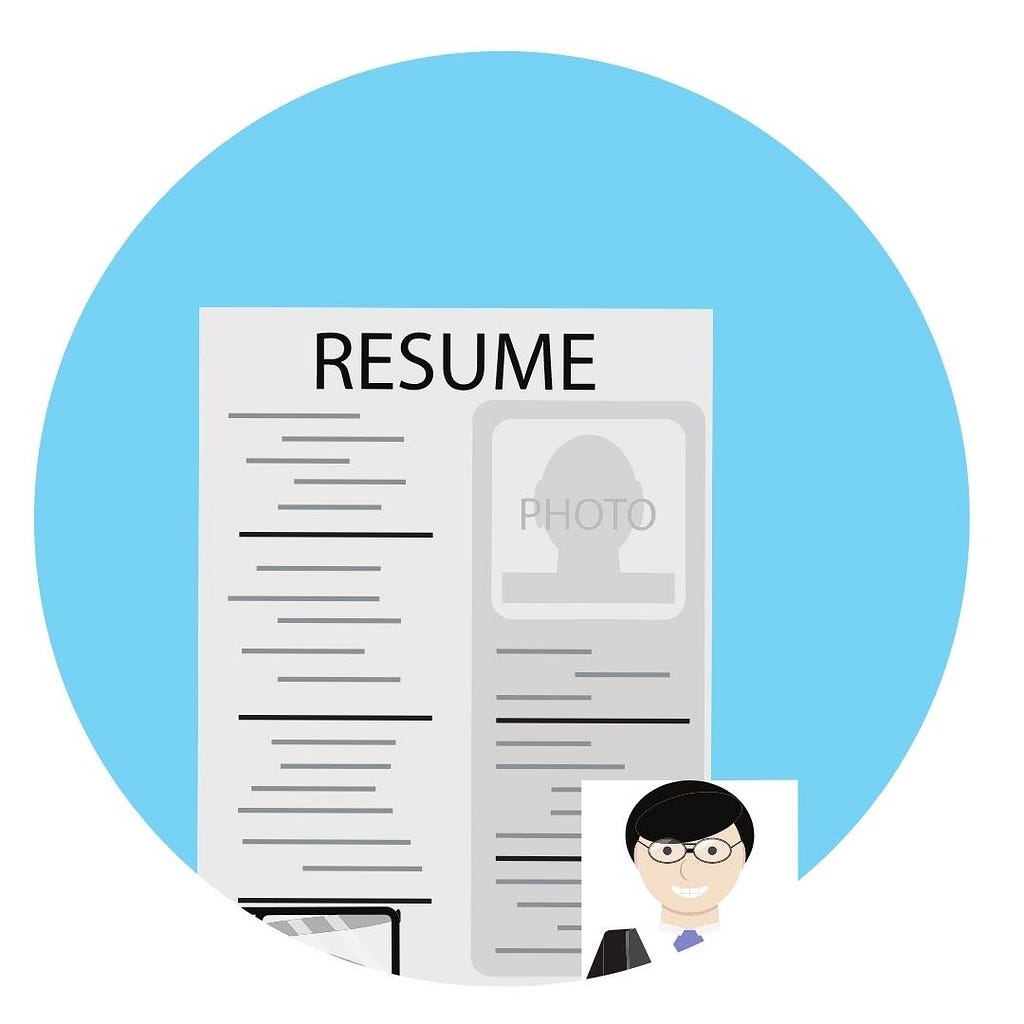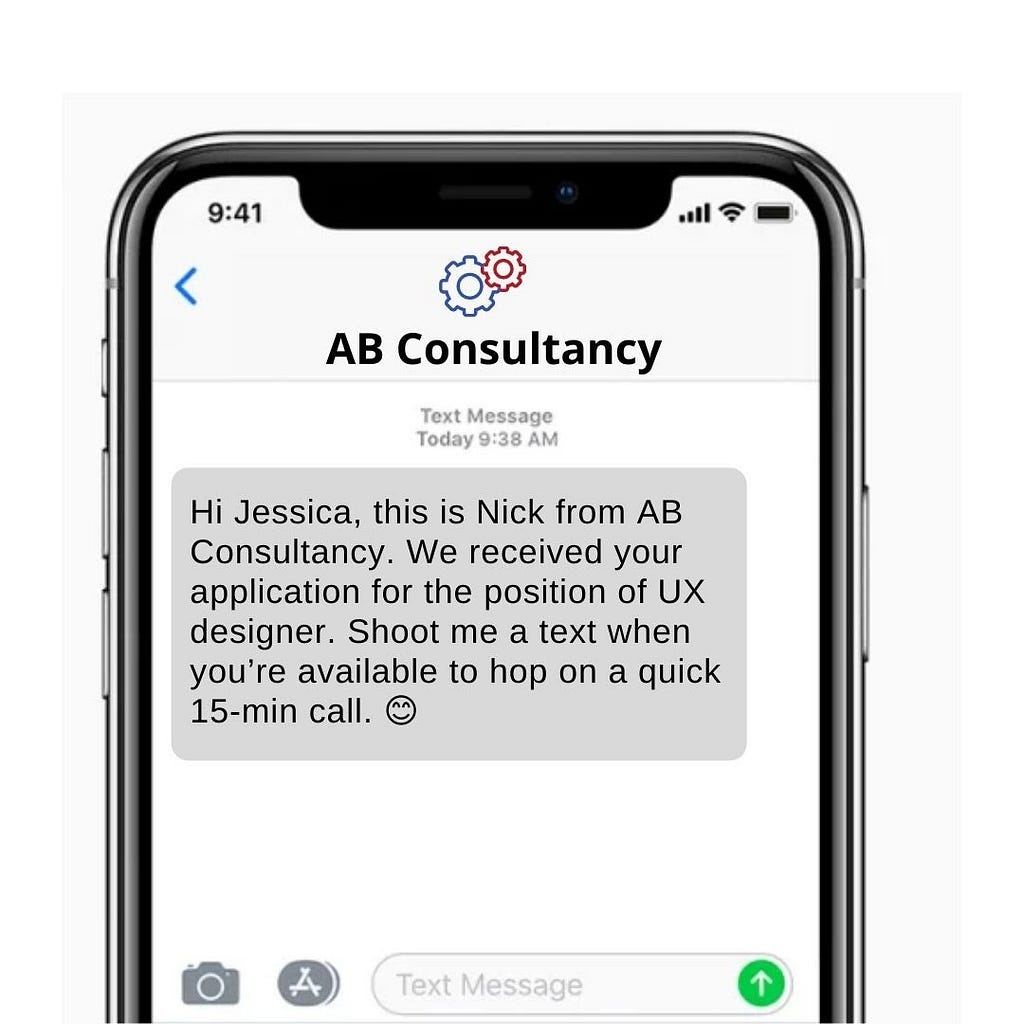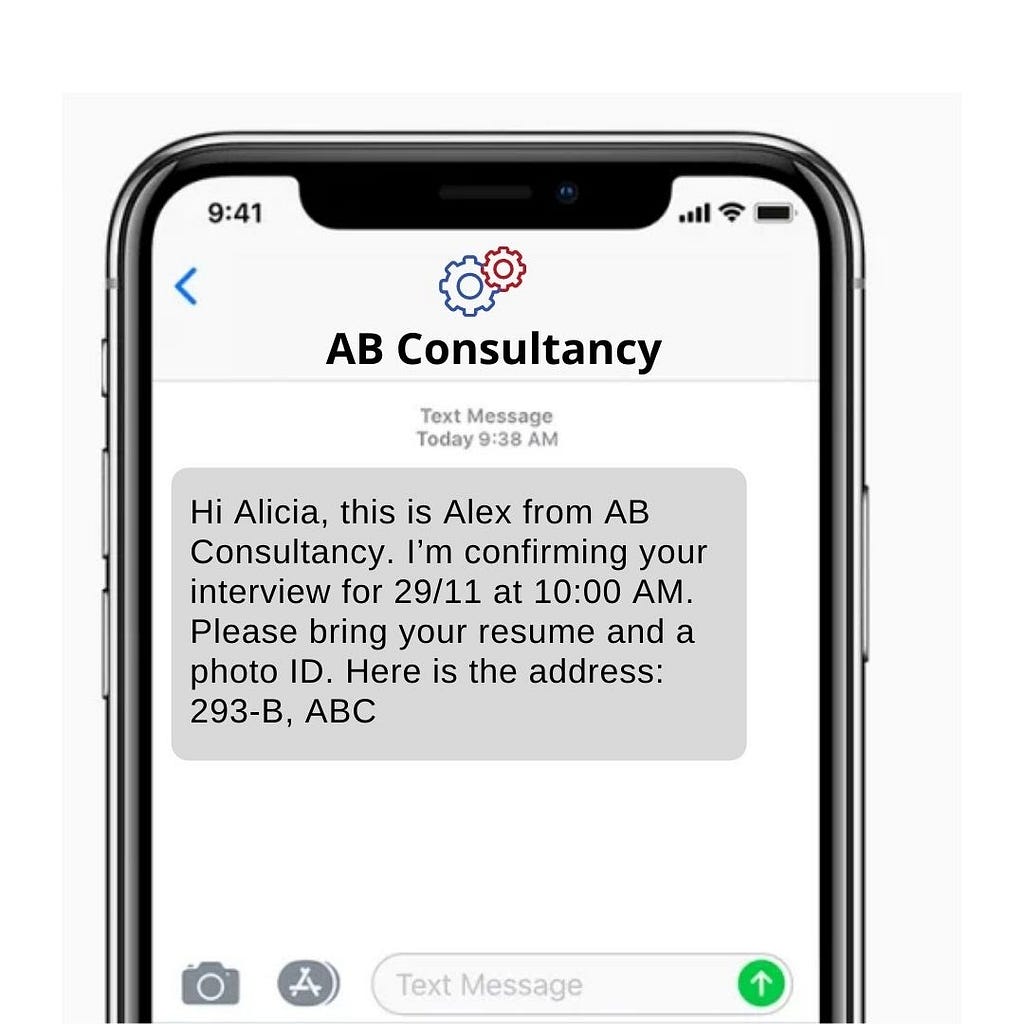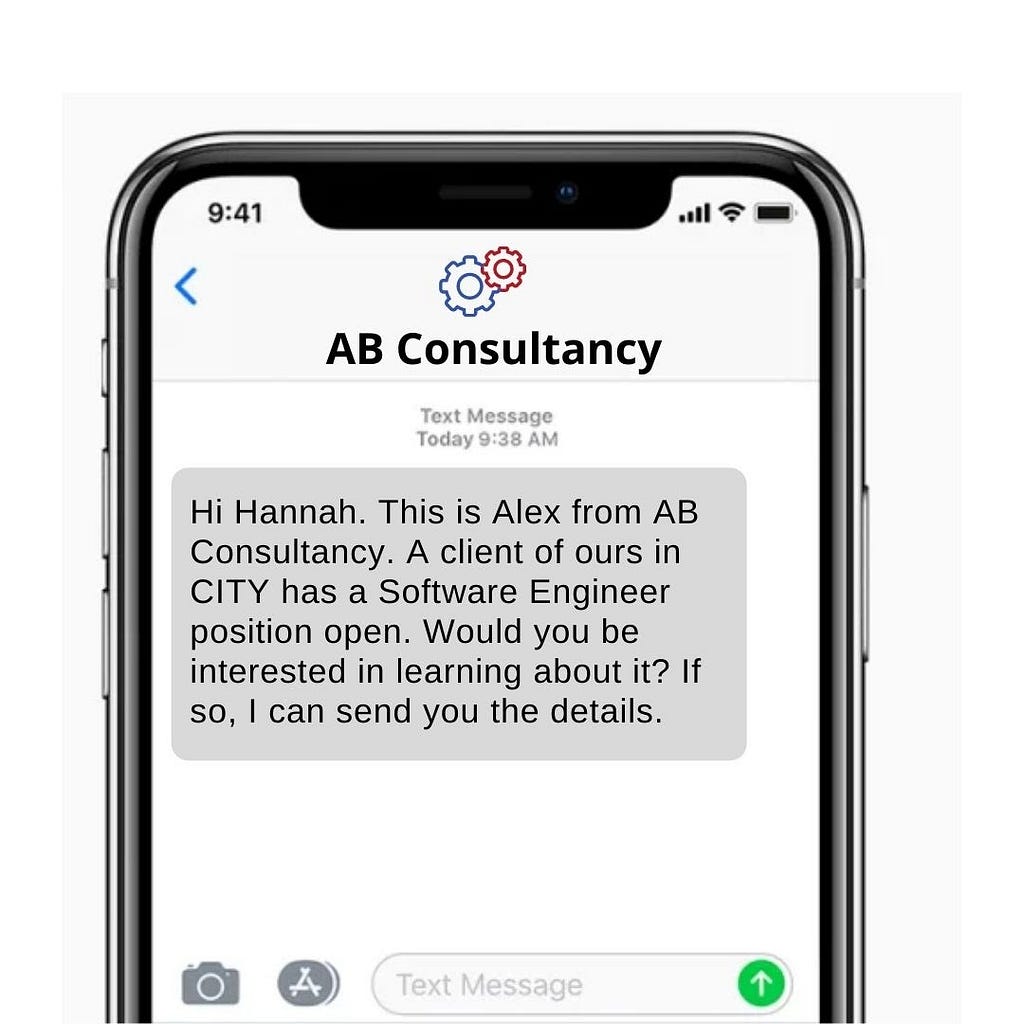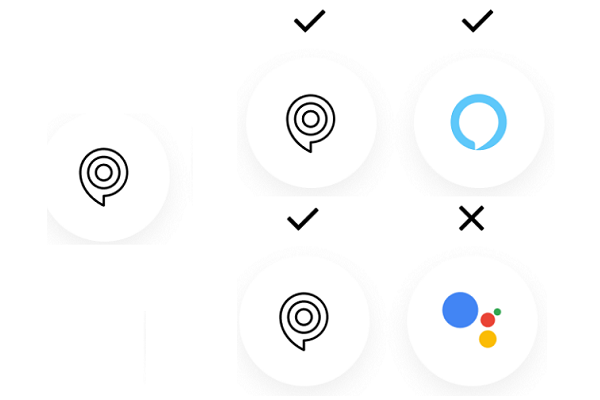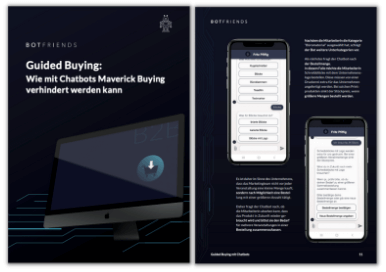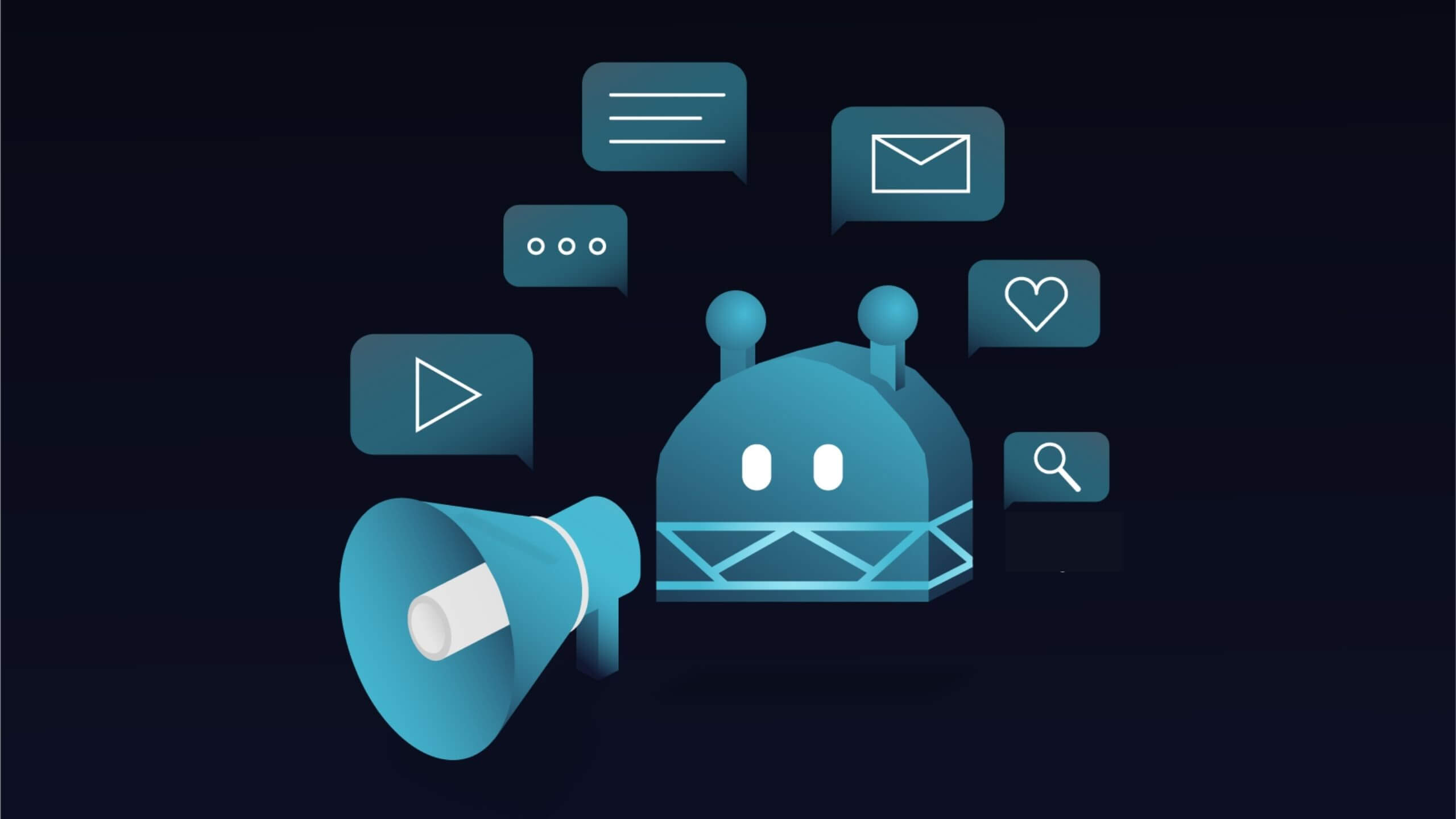Year: 2021
-
Recruitment and Staffing- Cloud Messaging
Employees are crucial to a company’s growth and success, and gathering a team with a varied range of personalities, passions, and skillsets is one of the most difficult components of any business.
Finding exceptional individuals and persuading them to apply is a difficult task that demands a team effort. It works similarly to how marketers attract and convert customers. This is where marketing for recruitment comes into play.
The average American looks at their phone 47 times every day. Because we’re all so glued to our phones, text messaging is a fantastic and mostly underutilized channel that skilled recruiting teams can employ to generate significant results.

Recruitment Funnel:
1. Attract: Text to Apply
2. Engage: Chat to Engage
3. Nurture: Respond to Rehire
4. Convert: Remind to Complete
Mass Marketing, Target Marketing, and Direct Messaging
Recruiters can use Cloud Messaging software to send mass messages and manage conversations from a dashboard. The software can also respond automatically and handle simple two-way communication without the need for human intervention. Additionally, these systems ensure that your messages follow data security and compliance guidelines: candidates’ information is kept private, and they can opt-out of receiving SMS.
You can use text messaging to engage with newer applicants as well as those who have been in your network for a longer time. Text candidates a link to a page that invites them to your next recruiting event or tells them about an employee in their job family.
- Keep informed with new job openings: Send a bulk text to candidates with a job Opening after segmenting your list based on criteria like Skill, or education level.
- Integrate Cloud Messaging with your HR software: This step is optional, but it can help you automate your SMS recruitment efforts significantly. Our API interface allows you to connect your existing applications to our platform.
- Send Targeted Job Opening: Send a bulk text to candidates with a job application after segmenting your list based on criteria like zip code or education level.
- Pre-Screen Candidates: To ensure you have a worthy applicant, send screening exams, questionnaires, or surveys by text.
- Interview Scheduling: Coordinate interview times as soon as possible or send a link to the interviewer’s calendar.
- Send Day-of Reminders: Nobody wants to be late for an interview. Neither the candidate nor the interviewer. Send a reminder with helpful information like parking instructions, directions, and more.
- Inform Applicants Who Weren’t Selected: You can’t make an offer to everyone. Applying for a job is difficult, and waiting for an answer maybe even more difficult. Candidates who were not chosen should be informed that they are no longer being considered.
- Send Job Offers/ Job Announcement: This is the most exciting aspect of the job search, and you’ll probably want to break the good news over the phone. Send exciting job offers to the candidates!
- Keep applicants updated: Just because a candidate wasn’t a good fit for a certain role doesn’t mean they wouldn’t work well with your team. Send them alerts about the new job positions available.
- Find new and qualified applicants: Texting is the most convenient, rapid, and extensively used method of communication. This is especially true when the employment market is flooded with technology-savvy millennials. While having a large number of candidates may appear appealing, you must ensure that they are qualified. Your team may communicate with numerous candidates at once with text recruitment software, automatically asking qualifying questions without having to make a time-consuming phone call. Better yet, an automated system such as Cloud Messaging can take care of it for you.
Trending Bot Articles:
2. Automated vs Live Chats: What will the Future of Customer Service Look Like?
4. Chatbot Vs. Intelligent Virtual Assistant — What’s the difference & Why Care?
- Re-schedule interview: In case of cancellation of the interview or conducting a second round of interviews, send a re-schedule interview text to the candidates! Do not forget to include necessary details eg. time, date, location, directions, etc.
- Engage Applicants With Two-Way Communication: Candidates frequently have issues, questions, and scheduling conflicts, all of which must be addressed. Two-way text messaging speeds up and simplifies the process of resolving these concerns. Candidates can ask questions, get quick responses, and notify potential employers of any concerns with their applications.
Recruiters can also use Text Marketing to:
- Send interview reminders
- Check-in after an interview
- Answer candidates’ questions
- Notify people of new opportunities
- Advertise new roles with Text to Apply
- Document request
- Job offered
- Job starting reminder
- Candidate referral
Why Cloud Messaging?
Cloud Messaging allows businesses to send vital messages quickly and keep in touch with their contacts. We’re delivering text messages for companies in healthcare, education, staffing & human resources, property management, utility, non-profits, and religious groups.
Because of our culture, we are distinct. It’s in our opinion, our most significant competitive advantage. We’re committed to providing excellent customer experiences and ensuring that our platform isn’t utilized for spam marketing or political statements.
Which medium (social, email, SMS, phone) do you find the most effective for contacting candidates as a recruiter? What are your opinions on contacting and engaging talent via SMS messaging? Let us know what you think by leaving a comment on our LinkedIn or Facebook pages!
Don’t forget to give us your 👏 !



Recruitment and Staffing- Cloud Messaging was originally published in Chatbots Life on Medium, where people are continuing the conversation by highlighting and responding to this story.
-
How to Design a Conversational Flow for Your Chatbot — EmpathyBots
How to Design a Conversational Flow for Your Chatbot — EmpathyBots
So, now you are ready to create a chatbot and want to learn more about each step!
Then, what are you waiting for?
Take your first step towards it and learn to design a conversational flow for your chatbot.
In this guide, I’m going to tell you the 5-step process that you need to follow to design an effective conversational flow (with an example).
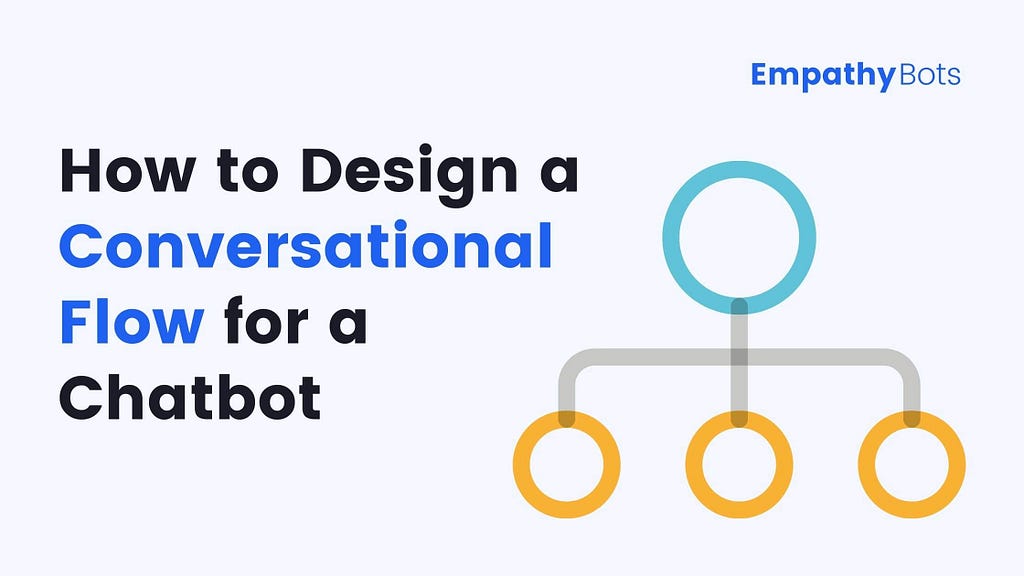
Source: EmpathyBots But before moving ahead, if you don’t know what is a chatbot and the step-by-step process to create it.
Then I highly suggest you to read these 2 guides,
- What Exactly is a Chatbot? And Why is it Important?
- How to Create a Chatbot from Scratch in 2021 (The Ultimate Guide)
Ok, Let’s start!
What is a Conversational Flow?
The conversational flow is nothing but a flowchart that represents an effortless progression of responses that happens in a chatbot based on conditions or values.
It is different than a conversational script. The conversational script is a set of dialogues in the conversation.
And, the conversational flow is the overall structure of your chatbot.
Now, I will tell you how to design a conversational flow by taking the example of FAQBot.

5 Steps For Creating a Conversational Flow
1. Know the Purpose and Bot Functionality
I hope that you know what it is!
If not, then refer to the 11 chatbot best practices guide, to learn in detail about the purpose and bot functionality.
To give you a brief idea, the purpose is nothing but the expectations you have from your chatbot and the functionality is how to fulfill those expectations.
Like, the purpose of my FAQBot is to answer frequently asked questions of users.
And I will fulfill it by creating prefixed question buttons that users can click on to get answers.
2. Consider All Scenarios
By scenarios, I mean that consider all possible situations that can occur during the conversation and design your conversational flow accordingly.
There are 5 main situations that normally occurs in a chatbot,
1. Greetings
This is the welcome message your chatbot has to send when users interacted with it.
You can choose to send different messages to new and return users.
2. Asking
There can be a situation when your chatbot has to ask users different questions to keep the conversation going.
Like, sending a “How can I help you?” message.
3. Suggestions
In a particular situation, you have to show users how your chatbot can help by showing the buttons or quick replies.
4. Failure
This situation can occur when users asked for something that is out of your chatbot’s scope.
In this case, your chatbot should send an apology message to users and direct them towards other possible options.
5. End
This is the end of a conversation.
Don’t end it forever. Users should feel like coming back to it.
Trending Bot Articles:
2. Automated vs Live Chats: What will the Future of Customer Service Look Like?
4. Chatbot Vs. Intelligent Virtual Assistant — What’s the difference & Why Care?
3. Draw an Outline
Now you know the purpose and functionality of your chatbot, it’s time to design a basic outline of it.
Simply visualize the flow of the conversation and draw it on paper or wherever you want.
This is the outline of my FAQBot,
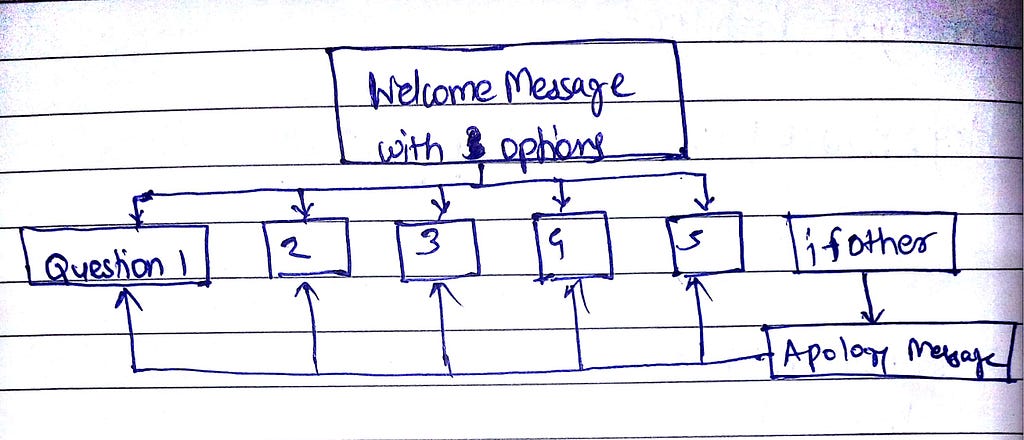
Source: EmpathyBots 4. Design a Conversational Flow
Now finally, it’s time to design a conversational flow.
You can use the free tool called Draw.io to design a flow (I personally used it).
Just draw the flowchart of your chatbot based on the conditional progression of responses.
This is how I have designed the conversational flow of my FAQBot,
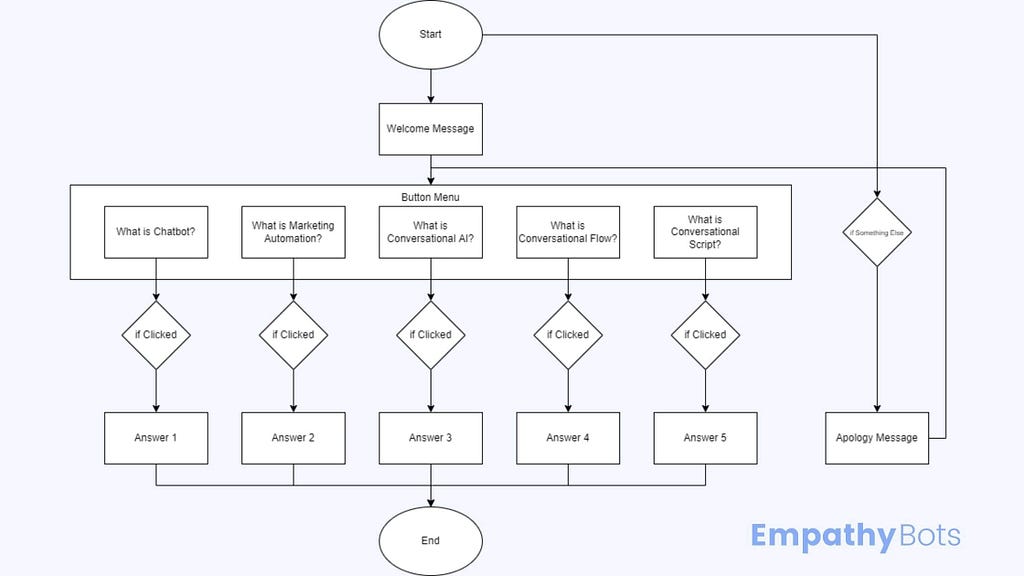
Source: EmpathyBots 5. Optimize
And, at last, optimize your conversational flow to give a top-notch conversational experience to your users.
Concluding Words for Conversational Flow
Conversational flow is like the foundation of your chatbot. That is why it should be strong.
Your entire chatbot’s performance depends on this.
So, take time to think, brainstorm, visualize, and follow these 5-steps to design it effectively.
Liked this story? Consider following me to read more stories like this.
Don’t forget to give us your 👏 !



How to Design a Conversational Flow for Your Chatbot — EmpathyBots was originally published in Chatbots Life on Medium, where people are continuing the conversation by highlighting and responding to this story.
-
Leak reveals the arrival of Sonos voice assistant
According to code strings shared on reddit the most awaited Sonos Voice Assistant is going to get launched soon……
-
Why your educational institute needs to use a WhatsApp chatbot
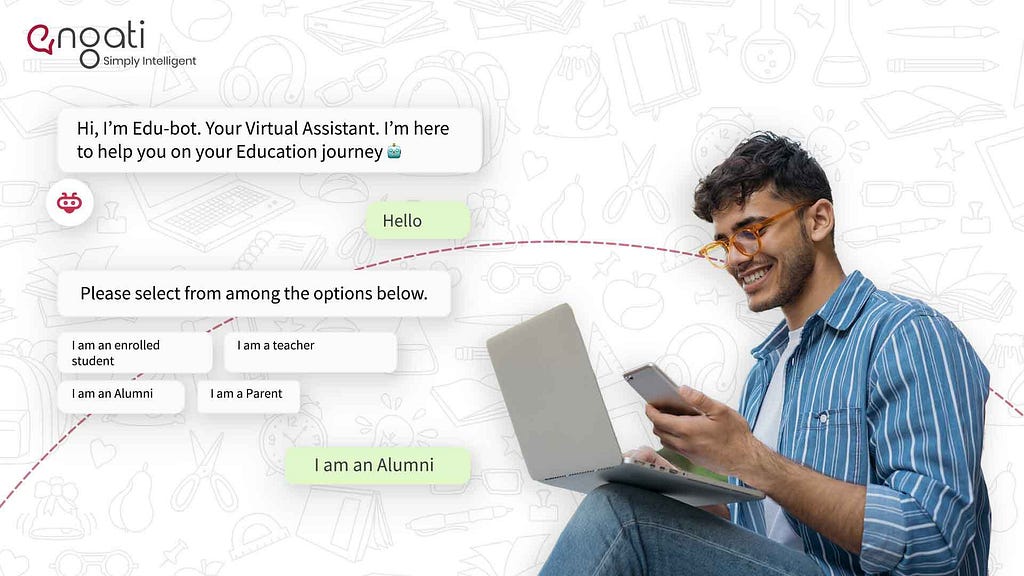
In today’s world, education goes beyond the walls of traditional classrooms. You need to be able to reach and educate your students over the channels that your students use the most. Noting that your students open WhatsApp 23 times daily and spend an average of 28 minutes on it every day, a WhatsApp chatbot would be a powerful tool for your educational institute.
How can WhatsApp chatbots be used for educational institutions?
Here are some use cases for WhatsApp chatbots in the education industry:
Driving admissions and enrollments
You can use your WhatsApp chatbot as a lead generation tool for your educational institute or eLearning platform. It gives you access to prospects on the messaging app they use the most and enables you to answer all their admissions and course-related questions right there without any delays, thus streamlining the enrollment process.
2. Onboarding new students
New beginnings are always confusing and riddled with anxiety. Students find themselves wondering how things are going to be and how their lives are going to change in their new universities or educational institutes. As an educator, you need to use your WhatsApp chatbot to introduce your students to the new place, make them familiar with the facilities available, their teachers, mentors, and let them know what clubs and committees they can join, as well as the activities that they can participate in.

3. Using it as a Learning Management System (LMS)
You can go beyond traditional classrooms by using your AI WhatsApp chatbot as an eLearning platform in the form of a learning management system (LMS). These education bots can be used to answer students’ questions, clarify their doubts, and could even be used to teach your students. You could use them to deliver lessons to learners in a conversational format.
This makes learning fun and interactive. It even gets students invested in the learning process, rather than letting them zone out and spend an hour in their own mental wonderland while pretending to listen to a professor deliver a lecture.
Since these bots are driven by artificial intelligence, they can even act as mentors for your students, especially during exam season. Picture this — your students are spending the night cramming for an exam and then…. boom, they run into a concept that they just cannot wrap their heads around. You’ve been there too, and your choices were pretty much limited to asking your peers for help (a typical ‘blind leading the blind’ situation), waiting for the morning to ask your instructor about it before the exam, or just skipping the concept, and hoping that your exam did not involve a question about that concept.
When you use your WhatsApp chatbot as a learning management system, your students get a more effective way to tackle that situation — all they need to do is drop a message on the WhatsApp bot and it will explain the concept whether it’s 11 pm or 5 am.
Trending Bot Articles:
2. Automated vs Live Chats: What will the Future of Customer Service Look Like?
4. Chatbot Vs. Intelligent Virtual Assistant — What’s the difference & Why Care?
4. Sharing resources
Your WhatsApp chatbot is definitely an effective way for you to share course materials with your students, but that’s not all that you can do with it. Education shouldn’t be limited to textbooks, and you can’t prepare people for the real world if your lessons stay within the confines of the course material.
As an instructor, you should share additional resources with your students that can supplement their coursework. Your bot can act as an eLearning platform here, sharing additional resources in the form of rich media or even links.
5. Communications with parents
Sometimes parents just aren’t in the loop and have no idea about what their kids are doing at school. Education chatbots are a great way for you to keep them informed and not leave them in a state of confusion. Whether it’s about exam results being released, or their children falling short of their attendance threshold, your education chatbot can keep the parents updated, which would be beneficial for teachers as well as students.
6. Broadcasting notifications
Your Engati WhatsApp chatbot can even be used to send out notifications and announcements by making use of WhatsApp message templates that you could create right over the Engati platform itself.
What could your educational institution use WhatsApp broadcast messages for?
1. Admissions lists
What’s the most annoying thing about checking admissions lists online? Sites just tend to take ages to load up whenever applicants want to check whether they got into the university. It’s a frustrating and anxiety-inducing situation for students.
WhatsApp chatbots can help you get around this issue.
When applicants opt-in for messages from your WhatsApp chatbot, you can create campaigns to broadcast messages to them about the admission lists that have been released so that they can easily check whether they’ve gotten into your institution or not.
2. Exam schedules
Released the schedule for the current exam cycle? You don’t need to put it up on a physical notice board or your website and hope that your students see it. You don’t even need to send an email and wait hours on end for them to open it. All you need to do is push it out on your WhatsApp chatbot as a broadcast message and your students will get a very overt notification.
3. Assignment submissions
With everything that students have going on with their lives, it’s very easy for them to just forget that they need to submit their assignments. You can use your WhatsApp bot to broadcast messages about the assignment topics when they’re declared, and even to send out reminders when they’re nearing the submission deadline.
4. Extracurricular activities
Are any of your committees organizing events? Are your sports teams holding tryouts? Maybe you’re organizing a Model United Nations conference?
A lot of students miss out on extracurricular activities because they simply don’t know that these are taking place or when they are happening. Broadcasting messages to them on WhatsApp helps you deal with this issue, ensuring that everyone knows what’s happening and is offered the opportunity to participate in these activities.
5. Fests
Let your students know when you’re organizing your college fests or are raising a contingent to participate in another college’s fests. Send messages with lists of the events that your students can sign up for and put their talents in the spotlight.
6. Exam results
This is always a stressful situation for students. Don’t leave them wallowing in anxiety, wondering when the results will be announced and if they cleared the semester. Just broadcast a message to them via your bot so that they know how they fared.
You can even send the message with a CTA button that takes them to your website or eLearning portal where they can access individual results confidentially or just send documents over to them directly over your WhatsApp eLearning bot.
7. New lectures uploaded to moodle server
Never leave your students wondering when they’ll get access to course material. You can use your bot to broadcast messages about new lecture recordings or learning material that has been uploaded to your Moodle server or LMS.
Best practices for using eLearning WhatsApp chatbots?
1. Speak your students’ language(s)
If you’ve got students migrating from their home country to study at your institute or even if you have students learning remotely, you need to engage them in their own language in order to provide them with high-quality education and make sure that they understand their teachers. and mentors.
2. Use bots as well as live chat
Allow your instructors to teach even beyond traditional classrooms by incorporating bots and live chat. This is especially useful during the exam season and would improve the learning experience.
You can also use live chat to answer complex administrative queries that the bot could not answer on its own.
3. Go omnichannel
Reach your students across all the channels that they spend time using. The best way to use chatbots for education is to tie conversations together across all these channels so that your agents always have context and your students don’t have to start the conversation from scratch whenever they switch messaging apps. Engati allows you to engage and educate your students over Facebook Messenger, Instagram, Telegram, and 10+ other messaging applications, in addition to WhatsApp.
How can you create an eLearning chatbot for WhatsApp?
Building an eLearning chatbot and deploying it on WhatsApp is an extremely easy process, but only when you’re building your bot with Engati.
All you need is a verified business on Facebook, a WhatsApp Business phone number, the WhatsApp Business API, and the Engati chatbot platform.
Here’s a quick walk-through on how you can build your WhatsApp chatbot, if you want a more detailed explanation, check out our guide on creating WhatsApp bots.

This article about “Why your educational institute needs to use a WhatsApp chatbot” was originally published in Engati blogs.
Don’t forget to give us your 👏 !



Why your educational institute needs to use a WhatsApp chatbot was originally published in Chatbots Life on Medium, where people are continuing the conversation by highlighting and responding to this story.
-
My first experience creating Chatbots
This week, my first job as a UX Designer in a large company came to mind: Designing and developing a chatbot for one of the sectors of this company.
I started with a survey about the characteristics and personality that the chatbot would come to have, based on the preferences of those working in the industry. After all, it would be an internal and daily communication about any doubts that might arise on their part.
During the process, preferences were changing. One moment they wanted a robot, another moment they wanted a robot animal, and ((only)) later they decided that it would make more sense to be a human.

Another survey was carried to discover their characteristics and personalities. Four more models developed.
Which would they prefer among the 4 chatbots drawn. One was chosen, but internally it was asked for changes. “Transform it into a super hero.”
Changes made tho. And two more surveys: the first opened up for suggestions, where we filtered out the ones that would make the most sense, and the second survey, the final choice. What would the name be?
Sam.
After that, I started to develop the communication part. Newsletter, presentation video, profile photo and other necessary visual documentation.
The content process and conversational practices were carried out by the sector itself directly with the developers. In other words, the most important part for a good experience, didn’t have the participation of a UX professional.
My work ended up creating the chatbot visual.
Trending Bot Articles:
2. Automated vs Live Chats: What will the Future of Customer Service Look Like?
4. Chatbot Vs. Intelligent Virtual Assistant — What’s the difference & Why Care?
Even though I was just an intern at the time, I should have shown the importance of my participation throughout the entire process. Today, I would do everything differently following a line of processes that actually work and improve the user experience. My strategy would be based on these 10 topics that I learned:
- Define a personality
- Heuristics
- Prioritize information and create conversations for each context
- Define requirements and userflows
- Application of good conversational practices
- Prototype
- Chatbot documentation
- Main interaction (URA and NLP)
- Define hypotheses, map user needs, prioritize features
- Create good conversational user interface practices for each type of channel
After all, that’s the idea of having a chatbot. Experience.
Don’t forget to give us your 👏 !



My first experience creating Chatbots was originally published in Chatbots Life on Medium, where people are continuing the conversation by highlighting and responding to this story.
-
Need help with chatbot development
Could you please suggest some resources on chatbot building from the conversational point of view? Best I could find were general tips or outdated information…
submitted by /u/belladonna73
[link] [comments] -
Wie Guided Buying und virtuelle Assistenten Beschaffungsprozesse einfacher gestalten können
Kennt ihr das auch? Eigentlich sollte ja nur schnell noch Nachschub für die Druckerpatronen bestellt werden. Aber dank des unübersichtlichen Kataloges und den neuen Anforderungen bei der Lieferantenauswahl dauert es mal wieder ewig…
Richtlinienkonforme Bestellungen für ein Unternehmen aufzugeben ist nicht immer einfach und kann viel Zeit und Nerven kosten. Und am Schluss auch bares Geld, da die Arbeitszeit der Mitarbeiter nun einmal auch vergütet werden muss und langwierige Bestellprozesse so auch die Transaktionskosten in die Höhe treiben.
In diesem Blog Beitrag erfahrt ihr:
- Was erschwert Mitarbeiter:innen das Abwickeln von Bestellungen?
- Was ist Guided Buying?
- Was sind Chatbots?
- Wie funktioniert Guided Buying mit einem Chatbot?
- Was sind die Vorteile von Guided Buying mit Chatbots
Was erschwert Mitarbeiter:innen das Abwickeln von Bestellungen?
Mitarbeiter:innen außerhalb des Einkaufs tun sich häufig mit Bestellungen schwer. Oftmals müssen sie eine Vielzahl sehr umfangreicher und nicht immer benutzerfreundlich gestalteter Online-Kataloge durchforsten, um den gewünschten Artikel zu finden. Zudem wissen sie oft nicht, wie sie richtlinien getreu eine BANF anlegen können.
Dies führt bei den Anforderern immer wieder zu Frustration und vielfach auch zu teuren Freitextbestellungen, die dann von der Einkaufsabteilung bearbeitet werden müssen. Oder die Mitarbeiter:innen kaufen direkt am Einkauf vorbei. Dieses sogenannte Maverick Buying führt dann zu höheren Kosten und anderen negativen Folgen für die Unternehmen.
Unternehmen können durchschnittlich 24% ihrer Ausgaben einsparen, wenn sie Maverick Buying verhindern. (Wucato)
Aber auch Einkäufer:innen haben immer wieder mit den Anforderungen bei der Lieferantenauswahl und Bestellprozessen zu kämpfen. Es müssen komplexe und umfangreiche Regularien und Richtlinien beachtet werden, um die Compliance Anforderungen zu erfüllen.
Hier sämtliche Aspekte, Rahmenverträge, Regularien und Ausnahmefälle auswendig zu können und stets fehlerfrei bei einer Bestellung zu beachten, ist für die Mitarbeiter:innen schlichtweg nicht möglich. Das Nachschlagen in den Regelwerken und Handbüchern kostet die Einkäufer:innen viel zu viel Zeit.
Um diesen Mitarbeiter:innen zu helfen, bräuchte es einen persönlichen Assistenten. Jemand, der ihnen das Navigieren dieser Kataloge erleichtert und selbst bei Fragen zum Lieferketten Gesetz die richtige Antwort parat hat. Für jeden Mitarbeiter einen echten, menschlichen Assistenten einzustellen ist natürlich nicht möglich. Aber das ist auch gar nicht nötig. Stattdessen können Unternehmen auf Guided Buying geführt durch Chatbots zurückgreifen:
Was ist Guided Buying?
Guided Buying ist eine Assistenzfunktion, die den Anwendern einen effizienten und komfortablen Einkauf ermöglicht. Anforderer und Einkäufer brauchen vor dem Bestellvorgang keine Anleitungen zu lesen, sondern halten automatisch die im Unternehmen festgelegten Beschaffungsrichtlinien ein.
Für diese Assistenzfunktion können zum Beispiel E Procurement Plattformen genutzt werden. Diese versprechen den Bestellprozess zu vereinfachen, aber im Grunde sind die Mitarbeiter:innen wieder mit einer weiteren komplizierten Aufgabe konfrontiert. Sie müssen auch hier erst einmal lernen mit der Plattform umzugehen und bei Fragen ist immer noch kein Ansprechpartner vorhanden. Sehr viel einfacher geht das mit Chatbots:
Was sind Chatbots?
Chatbots sind Dialogsysteme, die es Nutzer:innen ermöglichen, mit einem Bot in natürlicher Sprache zu kommunizieren. Es gibt regelbasierte Chatbots und smarte Chatbots, die mit Hilfe von Machine Learning die Fragen und die Absicht der Nutzer:innen verstehen und beantworten können.
Die Fähigkeiten von intelligenten Chatbots gehen aber weit über das simple Beantworten von einzelnen Fragen hinaus: Sie können Nutzer:innen durch komplexe Prozesse führen und Informationen abfragen sowie diese in Datenbanken hinterlegen.
Wie funktioniert Guided Buying mit einem Chatbot?
Dadurch dass der Austausch mit einem Chatbot in einem Dialog passiert, kann ein Bestellprozess wie ein Gespräch mit einem erfahrenen Kollegen oder Kollegin erfolgen:
Die Mitarbeiter:innen kontaktieren den Chatbot und teilen ihm mit, was sie bestellen wollen. Mit Hilfe von diversen Fragen holt der Chatbot dann die notwendigen Informationen ein. Er fragt beispielsweise nach der Bestellmenge, dem gewünschten Lieferdatum und anderen Anforderungen, die bei der Bestellung erfüllt werden müssen.
Wenn für ein Produkt verschiedene Ausführungen oder Lieferanten im System hinterlegt sind, kann der Chatbot für die Mitarbeiter:innen einen Vergleich vornehmen. Es ist aber auch möglich, dass der Chatbot die vom Unternehmen bevorzugten Produkte und Lieferanten den Nutzer:innen zuerst anzeigt. Des Weiteren kann er Bundles oder Kits vorschlagen. So wird sichergestellt, das miteinander kompatible Produkte bestellt werden.
In manchen Fällen ist es weniger ausschlaggebend, von welchem Lieferanten das Produkt geliefert wird, sondern vielmehr, ob eine bestimmte Menge zu einem bestimmten Datum zur Verfügung gestellt werden kann.
Hier kann der Chatbot automatisiert eine Anfrage an die Lieferanten schicken und die Verfügbarkeit des Produktes prüfen. Sobald die Informationen vorliegen, wird der Einkauf informiert und die Mitarbeiter:innen können die Bestellung vornehmen.
Wenn ein Schritt nicht klar ist, kann der Chatbot ihn erklären und Hilfestellungen geben. Es kann natürlich passieren, dass Nutzer:innen eine Frage stellen, die für die Bestellung selber nicht relevant ist. Zum Beispiel, wie der Status einer anderen Bestellung ist. Derartige Fragen kann der Chatbot beantworten und danach die Nutzer:innen zu dem vorherigen Prozess zurückführen.
Während des Bestellprozesses sorgt der Chatbot dafür, dass Regularien und Richtlinien eingehalten werden. Wenn Mitarbeiterinnen beispielsweise einen Artikel bestellen wollen, für den keine Freigabe vorliegt, weist der Chatbot darauf hin. Wenn möglich schlägt der Chatbot Alternativen vor, sodass die Bestellung ohne weitere Verzögerung weiter bearbeitet werden kann. Wenn es keine Alternative für den gewünschten Artikel gibt, kontaktiert der Chatbot die Person, die eine Freigabe erteilen kann.
Dies wäre auch der Fall, wenn die gewünschte Bestellung den maximalen Bestellwert überschreitet. Der Chatbot kontaktiert die verantwortliche Person und kann, sobald die Freigabe vorliegt, die Bestellung eigenständig ausführen. Die Anforderer bekommen in diesem Falle eine Bestellbestätigung per Mail von dem Chatbot zugeschickt. Wenn die Freigabe abgelehnt wurde, werden die Anforderer ebenso von dem Chatbot informiert.
Es ist auch möglich einen Bestellprozess zu unterbrechen und später wieder fortzuführen. Sei es, weil die Mitarbeiter:innen in ein Meeting müssen oder weil sie noch mit ihrem Vorgesetzten Rücksprache halten wollen. Wenn die Nutzer:innen das Gespräch wieder aufnehmen, kann der Chatbot auf den alten Gesprächsverlauf zurückgreifen und dort wieder anknüpfen. Darüber hinaus kann der Chatbot eine Erinnerung schicken, wenn eine Bestellung noch nicht abgeschlossen wurde.
Dies ist möglich, weil der Chatbot die einzelnen Personen ihren individuellen Mitarbeiterkonten zuordnen kann. Zu Beginn eines Gesprächs bittet der Chatbot die Nutzer:innen sich einzuloggen. So kann der Chatbot auf sämtliche von der Person bereits getätigten Bestellungen und andere hinterlegte Informationen sowie alte Gesprächsverläufe zugreifen und für die Interaktion mit den Mitarbeiter:innen nutzen.
Was sind die Vorteile von Guided Buying mit Chatbots?
Durch den Einsatz von virtuellen Assistenten können Mitarbeiter:innen ohne das Mitwirken der Beschaffung Bestellungen abwickeln. Dadurch dass der Einkauf nur in Einzelfällen herangezogen werden muss, werden die Einkäufer entlastet und haben mehr Zeit für andere Tätigkeiten. Für die Einkäufer selber wird es deutlich leichter richtlinien- und vertragskonforme Bestellungen zu tätigen, da der Chatbot ihnen bei der Anwendung der komplexen Regelwerke hilft.
Für international agierende Unternehmen eröffnet sich durch den Einsatz von Chatbots die Möglichkeit Prozesse weiter zu beschleunigen. Chatbots sind rund um die Uhr erreichbar und ermöglichen den nahtlosen Austausch von Informationen. Unterschiedliche Bürozeiten sind somit kein Problem mehr.
Die Akzeptanz einer Guided Buying – Lösung steht in direktem Zusammenhang mit dessen Benutzerfreundlichkeit. Chatbots können komplett ohne Vorkenntnisse bedient werden und können, anders als E Procurement-Plattformen, individuell auf die Nutzer:innen reagieren. Daher bieten sie sich besonders für ein Guided Buying an.
Wie viel Routineaufgaben an virtuelle Assistenten abgegeben werden und der Grad der Automatisierung der Bestellprozesse kann individuell an die Bedürfnisse und Wünsche von Unternehmen angepasst werden. So kann sichergestellt werden, dass einerseits die Mitarbeiter:innen optimal unterstützt werden, andererseits die MItarbeiter ihre Stärken voll einbringen können. Bei Vertragsverhandlungen mit Fingerspitzengefühl vorzugehen und Lieferantenbeziehung aufzubauen, die auf Vertrauen basieren, können Menschen nämlich immer noch am besten.
Ihr möchtet wissen, wie ein Bestellvorgang mit einem Chatbot im Detail aussieht? Dann holt euch unser Whitepaper „Guided Buying – Wie mit Chatbots Maverick Buying verhindert werden kann“
Ihr seid neugierig geworden und wollt wissen, was für andere Anwendungsbereiche es für virtuelle Assistenten in der Beschaffung noch gibt? Dann holt euch unser Whitepaper „Smarte Chatbots im Einkauf“:
Der Beitrag Wie Guided Buying und virtuelle Assistenten Beschaffungsprozesse einfacher gestalten können erschien zuerst auf BOTfriends.
-
Botify AI: Create. Chat. Bot.
submitted by /u/roblox22y
[link] [comments]
